The Interplay of Black and White in Interior Design
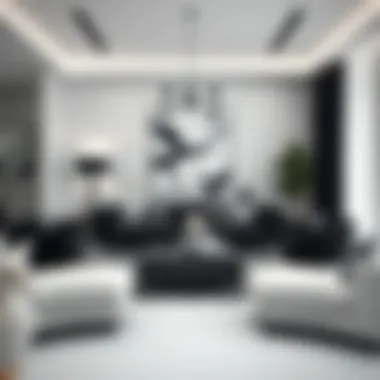

Intro
The dance between black and white in interior design is more than just a basic color palette; it's a study in contrast, elegance, and depth of soul. Imagine stepping into a room where the starkness of white meets the boldness of black, creating a dialogue that sings to the senses. A space like that doesn’t just dazzle the eye; it engages the mind and spirit as well.
In this exploration, we pull back the curtain on how these two colors have shaped spaces over time and continue to influence current trends in design. From the pristine brightness that white brings to any area, fostering feelings of calm and purity, to the grounding strength of black, which imbues a room with a sense of sophistication and depth, understanding their dual nature can unlock a world of design possibilities.
Let us wander through the significant design trends that highlight how contemporary styles and vintage inspirations utilize this contrasting duo to create stunning environments. We will dive into material innovations that transform concepts into tangible experiences, touching on sustainable materials that ensure our future and the smart technology that adds functionality without sacrificing style. Together, we will unravel the aesthetic appeal, psychological effects, and practical applications of white and black, arming you with insights that can enrich your own spaces and design projects.
Prolusion to White and Black Interior Design
The world of interior design is as diverse as it is fascinating, but one color pairing consistently stands out: black and white. This classic duo is not merely a matter of choosing two opposites; it represents a profound dialogue between contrast and harmony that can transform a space from mundane to extraordinary. Understanding how to balance these colors effectively can lead to interiors that not only look appealing but also convey a sense of sophistication and style.
Understanding the Color Scheme
Black and white are not just colors; they form a striking color scheme that carries a wealth of implications. While black is often associated with elegance and depth, evoking a feeling of intimacy, white tends to symbolize purity and openness, offering light and space to a room. This interplay creates dynamics that can be both energizing and calming.
When tackling the black-and-white palette, it’s important to consider not only the visual effects but the emotions they evoke. For example, a room painted in stark white can feel lively and vibrant. In contrast, when black is integrated as an accent, it adds weight and focal points, drawing the eye. This meticulous balancing act between the two hues offers designers the opportunity to craft a mood, whether it's inviting or dramatic, refined or edgy.
> "The beauty of black and white in design permits anyone to express themselves vividly, regardless of their experience or style preferences."
The Cultural Significance of Black and White
Colors carry significance that transcends mere aesthetics, often rooted in cultural implications. In various societies, black and white hues are loaded with meaning. Black can symbolize mourning or sophistication, seen in high-end fashion and luxury brands. Conversely, white is often linked to new beginnings or purity, as reflected in weddings and other celebratory occasions.
Moreover, black and white have played pivotal roles in art and design movements throughout history. From the stark contrasts of traditional Japanese ink paintings to the bold geometries of Art Deco, these colors have served as powerful tools for expression. Designers such as Coco Chanel and Yves Saint Laurent have famously utilized black and white to create iconic looks that are instantly recognizable. Their influences extend beyond fashion into the architectural and interior design worlds.
Historical Context of Black and White in Design
Understanding the historical context of black and white in design provides a rich backdrop that enhances the appreciation of their contemporary applications. The stark contrast between these colors has resonated throughout various periods in art and architecture, offering insights into societal norms and aesthetic preferences. By tracing their evolution, one can grasp how these two colors have shaped spaces and influenced perceptions across cultures.
The Evolution Through Art Movements
Art movements have constantly reevaluated and redefined the significance of colors, and black and white are no exceptions.
- Baroque Era - During the Baroque period, a play of light and dark—known as chiaroscuro—was essential. Artists like Caravaggio utilized this technique, creating dramatic contrasts that influenced interior design elements of the time. Homes and churches showcased these contrasts, employing blacks for depth and whites for purity and light, creating an awe-inspiring impact.
- Modernism - Fast forward to the 20th century, modernists embraced simplicity. The Bauhaus movement and influential figures like Le Corbusier favored minimalism, where black and white became the cornerstone of aesthetic unity. The flat planes of black and white in buildings and interiors echoed the calmness and clarity sought in everyday life.
- Postmodernism - Emerging in the late 20th century, the rebirth of color and pattern danced its way back into design, though black and white maintained their relevance. The juxtaposition of playful colors with stark monochromes allowed for a dialogue within spaces, emphasizing a space’s character while harkening back to earlier traditions.
In essence, the evolution of black and white in design can be viewed as a dialogue between simplicity and complexity, tradition and innovation. These colors have consistently demanded attention while allowing other elements to breathe in their presence. Art movements lay the foundation for understanding how they can transition harmoniously across various interior landscapes.
Impact of Architecture on Color Usage
The impact of architecture on the usage of black and white is palpable. Buildings, as the physical manifestations of design philosophies and artistic movements, influence interior choices.
- Influence of Structural Elements - Architects like Frank Lloyd Wright highlighted the importance of integration with nature, often employing white for a sense of openness and black for grounding elements like window frames and supports. This interplay allowed spaces to feel more connected to their environment, fostering an atmosphere of tranquility.
- Use in Urban Design - Many urban spaces utilize black and white to create striking visual frames. Consider the whitewashed stucco of coastal houses contrasted against black wrought iron railings. This not only makes a statement but serves practical purposes as well, allowing heat reflection and durability.
"Black and white design is not merely about the absence of color; it's about the dynamic interplay of light and shadow that reveals the character of a space."
As one delves deeper into the architectural framework, it becomes clear that black and white are not just colors. Rather, they encapsulate an ideology that emerges through various styles and periods. The built environment offers insights that inform how interiors are crafted, ensuring that these colors persist and evolve. Throughout history, black and white have been more than mere choices—they represent ideals that shape how we perceive and interact with our spaces.
Psychological Aspects of Color in Design
When we delve into interior design, the colors we choose can create profound psychological effects. This holds especially true for black and white, a duo that symbolizes both stark contrast and harmonious balance. Understanding the psychological aspects of color in this context is essential. It reveals how color affects mood, behavior, and even perception in interior spaces. This section elucidates how these colors intertwine with human emotions and the ambiance they create, showing their undeniable influence on design decisions.
Emotional Responses to Black and White
The emotional connections we have with colors stem from personal experiences and cultural backgrounds. Black, often associated with power and sophistication, can have a profound impact on feelings of elegance and seriousness. White, conversely, evokes purity, simplicity, and tranquility. This duality plays a pivotal role in setting the emotional tone of a space.
When using black, designs can shift from comforting to intimidating based on the intensity and context in which it's presented. For instance, a deep royal black can exude luxury in a lounge, while a flat black might feel overly heavy in a small apartment. To achieve harmony, it's essential to balance these choices with adequate white spaces—the empty canvas that brings calmness and clarity, avoiding the emotional pitfalls that excessive darkness can bring.
"Color is the keyboard, the eyes are the harmonies, the soul is the piano with many strings."
– Wassily Kandinsky
A thoughtfully designed black and white room can evoke a range of emotions from energetic to serene, depending on how these colors are structured. Sharp contrasts, when used mindfully, can uplift and energize. However, it is crucial to pay attention to how variations in shades can produce emotional turbulence. The emotional responses connected to these colors make them essential tools for designers looking to evoke the desired feeling in any given space.
Creating Ambiance with Color Choices


Ambiance is the mood or feeling of a space, established largely through color selection. In the realm of black and white, the combination offers versatility that can greatly influence how one experiences a room. In a living space, a predominantly white backdrop may induce calm and openness, making the area feel larger and more inviting.
On the flip side, integrating black accents can add depth and sophistication. Varying the proportion of the two colors can also change the ambiance. A room saturated in white with black furniture creates a minimalist look, while darker walls with white trim can establish a dramatic flair. This dance of brightness and shadows can draw the eye and create points of interest, contributing to the overall ambience.
In practical terms, here are some considerations for creating ambiance with black and white:
- Layering Textures: Using various textures, like matte and glossy finishes, can elevate the emotional resonance of these colors. A matte black wall paired with a glossy white sofa can bring visual dynamism.
- Incorporating Natural Elements: Adding wooden elements or greenery can soften the starkness of a black and white scheme, infusing warmth into the space.
- Lighting Conditions: The way light interacts with black and white surfaces can drastically change the feel of a room, altering how colors are perceived throughout the day.
The proper balance of black and white, accentuated with thoughtful decor elements, transforms a space into a thoughtful retreat. It’s not merely about aesthetics but crafting an environment that influences how one feels and interacts within it.
In summary, the psychological aspects of using black and white in design transcend mere color choices. They serve as powerful tools that shape emotional responses and establish ambiance, providing both homeowners and designers with a blueprint for creating spaces that resonate deeply with their inhabitants.
Design Principles for Using Black and White
The combination of black and white in interior design requires a keen understanding of various design principles. These principles not only guide the aesthetic outcome but also define the functionality of spaces. When woven together correctly, these two colors create an environment that feels cohesive, balanced, and visually striking. Homeowners, interior designers, and decorators often look to these principles to ensure the right elements mesh well and convey the desired emotions.
Balancing Light and Dark
Achieving a harmonious equilibrium between light and dark is crucial when employing black and white in interior design. It dictates the ambiance of a space. For instance, if a room is predominantly white, it can evoke a sense of openness and airiness, while the excessive use of black may create a feeling of intimacy and coziness. However, leaning too far into one shade can lead to a lackluster design.
To keep things aesthetically pleasing:
- Use dark accents to ground a predominantly light space.
- Introduce lighter furniture or decorations in darker rooms to break up the visual mass.
- Let in natural light where possible, making sure the balance stays right.
A great way to visualize this is by thinking of a yin-yang symbol, where both colors coexist cooperatively while highlighting each other’s strengths.
Contrast and Visual Dynamics
Contrast plays a pivotal role in making the design lively and engaging. A well-implemented contrast strategy doesn’t just stop at colors; it stretches into shapes, sizes, and styles. For instance, a sleek black leather sofa can be beautifully juxtaposed against a white, textured wall. This type of contrast draws the eye and creates focal points throughout a space.
Here are key strategies to elevate contrast:
- Mix linear with organic shapes; think of geometric black tables paired with soft, white rounded chairs.
- Use graphic patterns in rugs and wallpaper to create interest.
- Employ lighting strategically, as a well-placed lamp or fixture can enhance both colors dramatically, infusing energy into a room.
"Contrast is not just about opposites; it's about harmony created through differences."
Texture and Material Considerations
Texture is often the unsung hero in black and white design. It's one thing to have a color combination; it’s another to make it engaging. Textiles, finishes, and materials can play a significant role in elevating the design experience. For example, a mix of glossy black surfaces with matte white elements creates a rich depth.
Key material and texture strategies include:
- Combine various finishes; use a glossy black countertop with a matte white cabinetry for a stunning visual interplay.
- Incorporate textiles; think of plush white pillows on a black couch or a knitted black throw on a white chair for an inviting feel.
- Choose natural materials; wood, stone, and metal in black and white can offer a raw yet refined look.
Altogether, understanding these design principles empowers you to utilize the dynamic duo of black and white effectively, crafting spaces that are not just visually arresting but also resonate emotionally.
Styles Incorporating Black and White
In the realm of interior design, black and white offer a unique canvas—like the finest canvas seen in a beautiful art gallery—that gives it possibilities for luxury, simplicity, and depth. Styles incorporating these colors reflect a variety of aesthetics, each with its own compelling elements, advantages, and specifics worth considering. Whether one is sprucing up a home or looking to redesign a commercial space, understanding these styles can enhance both the visual appeal and functionality of the environment.
Modern Minimalism
Modern minimalism embraces the motto of "less is more." In this design philosophy, black and white serve not just as colors, but as fundamental elements that outline the essence of this style. Homes adopting modern minimalism often feature clean lines, open spaces, and carefully chosen furniture pieces that are devoid of frivolity.
- Focus on Functionality: Each element is selected for its usefulness. When incorporating black and white, furniture may sit stark against walls painted in contrasting shades, making it practical yet striking.
- Play on Textures: Smooth surfaces mixed with rough ones add dimension while keeping the palette neutral. Think about the contrast between a sleek black leather couch and a soft white wool rug.
- Use of Natural Light: Large windows enhance the simplicity of the color palette while enabling play with shadows. The light of day juxtaposes the darkness and brightness, creating an atmosphere both calming and invigorating.
In this approach, it's crucial to remember that the goal is serenity, achieved through stark contrasts marked by careful consideration of composition and arrangement.
Art Deco Influences
Art Deco is often seen as a glamorous style that thrived in the early 20th century, marked by a bold aesthetics that sought opulence and sophistication. Black and white were commonly harnessed to create striking visual impacts in numerous living spaces and public buildings.
- Geometric Patterns: Arches, zigzags, and angular designs bring life to surfaces when accented in black against white backdrops, striking a balance between elegance and boldness.
- Luxe Materials: In Art Deco interiors, polished marble, glass mirrors, and metallic finishes often come into play, creating a luxurious feel without drowning out the monochromatic palette.
- Layering with Accessories: Think about how gold and silver can be introduced through decorative elements like vases or light fixtures without overshadowing the fundamental black and white theme.
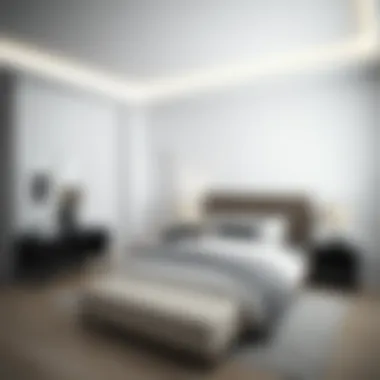
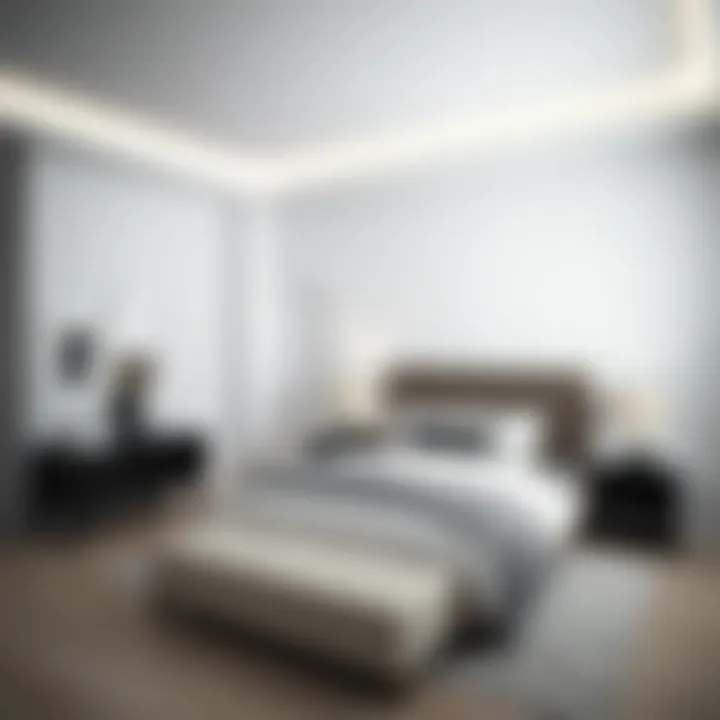
With Art Deco, the key is to embrace extravagant details while ensuring that the black and white scheme remains an integral part of the design.
Classic Monochromatic Spaces
Classic monochromatic spaces include a time-honored tradition where black and white engage in an elegant interplay reminiscent of timeless sophistication. Like a classic film, the simplicity of this palette maintains relevance across generations.
- Unified Color Scheme: When designing with a monochromatic strategy, each room becomes a study in shades and shades of black and white. One can create a dynamic effect by using various tones of grey as well to bridge the two colors.
- Art and Decor: Big pieces of art usually pop against white walls while fitting right into a bolder black framework. Classic styling encourages the inclusion of statement pieces that command attention without overwhelming other aspects of the room.
- Traditional vs. Contemporary Blend: Classic monochromatic styles can blend old-world charm with modern sensibilities, creating a hybrid that serves both comfort and contemporary needs.
Choosing classic monochromatic styling allows one to explore elaborate details without competing colors interfering. This amalgamation offers a unique appeal that stands the test of time.
The beauty of black and white within various styles lies in their versatility and timelessness, making them a staple for anyone wishing to achieve balance and elegance in design.
Practical Tips for Implementing Black and White Design
The world of black and white design isn’t just a game of opposites; it’s an intricate dance of balance, elegance, and emotion. When considering how to implement these colors effectively, homeowners and designers alike ought to recognize a few practical tips that enhance both aesthetic and functionality of the space. Striking the right chord between the two extremes can create a space that feels harmonious and sophisticated.
Choosing the Right Shades
Selecting the perfect shades of black and white is crucial. Not all whites and blacks are created equal; slight variations can have a significant impact on the overall atmosphere of a room.
- Warm vs. Cool: Warm whites, like cream or ivory, can provide a softer, inviting feel. In contrast, cool whites, which lean toward a bluish hue, can make a space feel crisp and modern. Similarly, soft black can have undertones that soften a room, while jet black can add a dramatic flair.
- Paint Samples: Always test a few samples in the space it's intended for. The sunlight, furniture, and even time of day can affect how a color appears.
- Matte vs. Glossy Finishes: A matte finish can evoke warmth and coziness, while glossy surfaces can reflect light and lend a more polished look. Think carefully about where you use each finish—like applying gloss on an accent piece for visual interest.
Integrating with Other Colors
While black and white can be captivating on their own, integrating them with other colors can enhance the overall design. Mixing shades can bring depth and liveliness to the space. Here are some approaches:
- Accent Colors: Use vibrant accent colors like emerald green, royal blue, or deep red against a black and white backdrop. These pops of color can uplift the monotony of the duo and create focal points within the space.
- Nature-Inspired Hues: Earthy tones, such as browns or soft greens, can ground the bold contrast of black and white. They encourage a sense of balance, connecting the starkness of these classic colors with a more organic feel.
- Graphic Patterns: Think about patterns—stripes, geometric designs, or floral prints—and how they can be incorporated. A black and white rug or throw can be a striking centerpiece, adding layer and visual dynamics.
Utilizing Furniture and Accessories
Furniture and accessories play a pivotal role in supporting the black and white theme, often becoming the true heroes of the narrative.
- Statement Pieces: Invest in high-impact pieces, such as a grand black sofa or a sleek white dining table. These elements anchor the room, making a strong statement without overwhelming the space.
- Layering Textures: Mix materials like leather, wood, metal, and textiles to add comfort and interest. For instance, a soft white faux fur throw on a black leather chair can marry comfort with style, striking a balance.
- Art and Decor: Choose artwork that encapsulates the duality theme—black and white photography or abstract prints can enhance your design ethos. Accessories like monochrome vases or sculptures can, also, bridge the gap between the two colors elegantly.
"In design, every color choice tells a story. The journey of black and white is about finding harmony where there seems to be none."
In essence, implementing black and white in design isn’t just a matter of slapping two colors together. It’s about artistry, balance, and understanding the nuanced roles each element plays in creating a space that speaks volumes. Engagement with these practical tips will elevate your design game, turning your vision into a coherent and stunning reality.
Case Studies of Successful Implementations
Exploring the contrast of black and white in interior design goes beyond mere theory; it’s essential to delve into real-world applications. Case studies serve as a window into the practicalities of implementing this elegant color scheme. By dissecting specific instances where these colors have been skillfully harnessed, we can shed light on the advantages they bring to both residential and commercial environments.
Contemporary Home Review
When tackling interior design in modern homes, the interplay of black and white can create striking visual narratives. A recent renovation of a suburban house in Austin, Texas, exemplifies this quite vividly. The homeowners sought a design that felt both fresh and timeless, marrying modern minimalism with classic touches.
Walking through the front door, one immediately senses the balance between dark and light. The open-concept living space features crisp white walls that reflect natural light, accented by handcrafted black furniture. The elegance continues with walnut wood floors that ground the design. A bold black feature wall not only draws attention but simultaneously serves as a backdrop for art pieces that ignite dialogue among guests.
In this home, black and white are not just colors; they embody the homeowners' values of sophistication and comfort. The clear separation and rich contrast lend an airy feel that doesn’t overwhelm. Their choice of light fixtures, a mix of polished chrome and matte black finishes, ties everything together harmoniously. This case study emphasizes the adaptability of black and white, suggesting that their versatility can suit various tastes while remaining stylish.
"Colors act as the soul of a room. Black and white create a canvas that resonates with shadows and light, bringing out textures and forms in a unique way."
Commercial Space Analysis
Switching gears to the commercial sector, let’s look at a boutique café in San Francisco that has embraced the duality of black and white in its design. This space illustrates how businesses can leverage color to influence customer experience and brand identity.
Upon entering the café, patrons are greeted with a sleek black-and-white aesthetic that is both inviting and energizing. The use of glossy black countertops contrasts sharply with the soft, white walls, creating an engaging atmosphere. This design choice not only enhances the café's modern vibe but also makes the brand appear sophisticated in the eyes of customers.
Furthermore, the strategic use of white tiles in the back counter area provides a charming canvas for the café's menu display, while high ceilings make the space feel spacious rather than cramped. Black metal chairs and tables offer a chic yet practical solution for patrons looking to settle in for a cozy chat or a quick catch-up with colleagues.
The cafe successfully captured attention through clever, modern artwork in black frames against white paint, making it a social hotspot where people want to linger. This example highlights how effective the paired colors could be in not just aesthetic appeal but in fostering a lively environment suited for business.
Both of these case studies underscore the importance of understanding the context of black and white in interior design. Through practical implementations, one can learn the tasks at hand and adapt design principles to serve their unique needs.
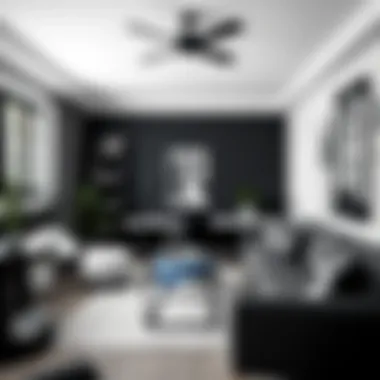
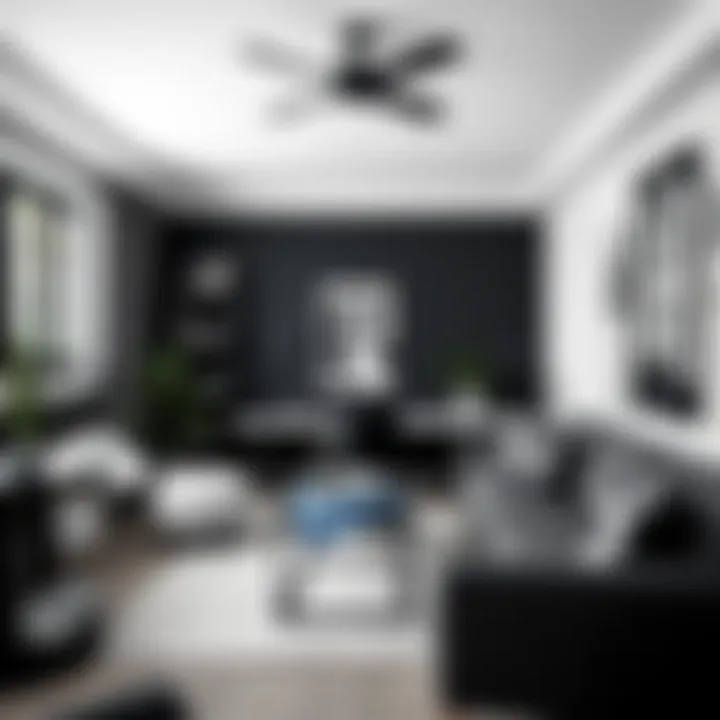
Challenges of Black and White Design
The interplay of black and white in interior design, while visually striking, brings a set of challenges that can make or break a space's success. Understanding these challenges is crucial for homeowners, interior designers, and anyone looking to leverage this timeless color scheme for their projects. The duality of these colors presents unique benefits and considerations that must be tackled head-on. By recognizing potential pitfalls, designers can achieve balanced aesthetics without compromising on comfort or livability.
Overcoming Monotony
Monotony is one of the primary concerns when working with a strictly black and white palette. It’s all too easy for a space to feel sterile or lifeless, especially if the design lacks variety and engagement. To combat this issue, incorporating diverse textures and materials can be invaluable. For instance, the soft touch of a plush white rug can provide warmth that balances the sharpness of black leather furniture. Similarly, mixing finishes—like matte and glossy surfaces—creates a layered effect that keeps the eye moving.
- Layering Textures: Introduce natural elements like wood or fabric to add depth.
- Accent Pieces: Consider using contrasting colored accessories, like vibrant cushions or artwork, to break the monotony without overshadowing the primary palette.
- Strategic Lighting: Effective lighting can drastically affect the perception of a space. Soft, warm lights can soften the harshness often associated with black and white designs and encourage a more inviting environment.
By weaving these strategies into the design process, one can maintain that crisp aesthetic while enriching the experience.
Avoiding Harshness and Coldness
Harshness in a black and white space is another common concern. These colors can easily skew towards a cold ambiance if not approached carefully. To ensure spaces evoke a sense of warmth and comfort, it’s essential to reconsider the scale and integration of the elements used. A balance between bold statements and softer features can transform a potentially stark design into an inviting haven.
- Warm Tones: Incorporate softer shades of white, like cream or ivory, to create gentle contrasts that elevate the space.
- Artwork and Decor: Including unique artworks or personal décor can humanize a black and white space, infusing it with personality and warmth.
- Furniture Choices: Opt for furniture pieces that are curvier or feature subtle details, which can soften the sharp lines often found in monochromatic designs.
By carefully considering the elements of warmth and softness in design, one can steer clear of a cold and uninviting atmosphere.
"Designing in black and white requires a keen eye for detail and a willingness to experiment to ensure the space feels alive and engaging."
In summary, addressing the challenges of monotony and harshness in black and white design requires thoughtful planning and creative solutions. When executed with care, these elements can transform interiors into stunning showcases that embody elegance and sophistication, while still being warm and inviting.
Future Trends in Black and White Design
The world of interior design is ever-evolving, and the black and white palette continues to hold a significant place within it. This section shines a spotlight on future trends in black and white design, specifically underscoring their relevance in contemporary and upcoming spaces. Integrating this classic color combination presents an opportunity to create not only aesthetically pleasing environments but also functional and sustainable ones.
As environmental concerns grow and technology advances, designers must consider how the duality of black and white can align with these changes. Homeowners and designers alike are increasingly drawn to eco-friendly materials and the seamless incorporation of smart technology, both of which will be discussed in the following subsections.
Sustainability and Eco-Friendly Materials
Sustainability in design isn’t just a buzzword; it’s becoming a necessity. Incorporating eco-friendly materials within the black and white scheme allows for a responsible approach to elegance. This includes using sustainably sourced woods, recycled metals, and non-toxic paints, all dressed in classic shades.
Consumers are becoming more conscientious about where products come from and their impact on the environment. Black and white can still be achieved using materials such as:
- Bamboo - This fast-growing grass can be crafted into furniture or flooring, offering a sleek look.
- Reclaimed Wood - Perfect for accent walls or furnishings, its character speaks to history while maintaining a sophisticated tone.
- Natural Fabrics - Linen and organic cotton in black and white patterns add texture without harmful chemicals.
By opting for these materials, not only is one fostering a healthy environment, but also one is ensuring that homes carry a sense of responsibility and consciousness. Eco-friendliness should not compromise aesthetics; it is possible to create luxurious spaces that also advocate for sustainability.
Smart Technology Integration
The future of design is undoubtedly intertwined with technology. Smart homes are increasingly recognized for providing convenience and enhanced living experiences. The integration of smart technology into black and white spaces can yield functionality beyond expectations.
Here are some examples of how one could blend technology with a classic palette:
- Smart Lighting - Adjustable lighting that shifts from bright white to warm tones can alter mood and emphasize the contrasting colors beautifully.
- Automated Shades - Motorized window coverings can be set to open or close based on the time of day, maximizing natural light while maintaining privacy.
- Home Automation Systems - Systems that allow for control over various aspects such as security, temperature, and entertainment can be aesthetically integrated into walls or furnishings in sleek black or crisp white finishes.
As smart technology continues to develop, it presents an opportunity to make the functionality of black and white spaces more prevalent and appreciated. This forward-thinking approach ensures that interiors remain relevant and efficient, reflecting the latest advancements while maintaining a timeless essence.
Designers and homeowners alike must embrace these changes, not just as trends, but as elements that will shape the future of living and aesthetics. The balance of black and white embodies a sophistication that remains, but adapting to sustainable choices and technological innovations is where the magic truly lies.
"Future trends in black and white design not only define aesthetic preferences but also reflect our commitment to sustainability and technology in creating meaningful spaces."
In summary, as we look ahead, the black and white palette offers a nexus of style, sustainability, and smart functionality that appeals to diverse audiences. By understanding these trends, one can effectively harness the duality of these colors to create spaces that are both timeless and forward-thinking.
The End
The conclusion of this article serves as a critical recap of the intricate relationship between black and white in interior design. The interplay of these two colors is not merely a matter of aesthetics; it encompasses deeper emotional and cultural significances. By summarizing the key points discussed throughout the article, we undersore the lasting appeal and versatility of this color scheme.
The Timeless Appeal of Black and White
Black and white design transcends fleeting trends, standing as a classic choice in any interior environment. These two colors possess a unique ability to unify disparate elements, creating spaces that are both harmonious and dynamic. Homeowners and designers alike appreciate the clarity and boldness that black and white afford when skillfully applied.
"Simplicity is the ultimate sophistication." – Leonardo da Vinci. This quote encapsulates the essence of black and white décor, emphasizing how minimalism can speak volumes.
This timeless duo offers a blank canvas, allowing for creativity and personal expression. Here are some specific elements that exemplify their enduring elegance:
- Versatility: Black and white can effortlessly adapt to various styles. From chic modern apartments to rustic countryside cottages, this color pair enhances and elevates the aesthetic, no matter the context.
- Contrast: The stark difference between black and white creates an eye-catching effect, drawing attention and guiding the viewer through a space. It's about balance—the dark anchors the light, and vice versa.
- Psychological Impact: Colors can influence our mood. In spaces where black and white are employed, one may experience feelings of calmness and clarity, fostering an environment conducive to both relaxation and productivity.
- Timelessness: Unlike trends that can fade away, black and white remains ever-present. New design movements will come and go, but this classic combination will retain its charm and relevance.
In essence, the appeal of black and white is not just in how they look but in what they represent. They invite creativity, inspire harmony, and provide a palette that is as adaptable as it is striking. By keeping these elements in mind, homeowners and designers can navigate the intricacies of interior design, ensuring that the use of black and white continues to resonate deeply within both personal and public spaces.















